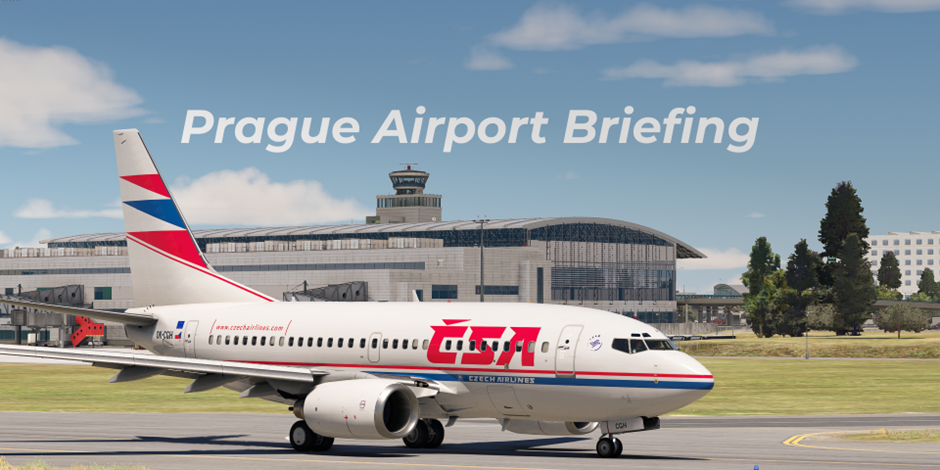¶ Prague Airport
The information in this document is not intended for real aviation. It is intended only for computer-based flight simulation.

Václav Havel Airport Prague (LKPR/PRG), formerly Ruzyně Airport, now named after the first president of the Czech Republic, is the main base of SW Group Virtual, and continuously the airport with the largest number of available flights on our virtual airline.
This document summarizes essential information you should know for a realistic flight simulator experience.
For more information, please refer to the real-life Aeronautical Information Publication (AIP):
https://aim.rlp.cz/ais_data/www_main_control/frm_en_aip.htm
¶ Scenery
Recommended LKPR scenery for MSFS:
Tailstrike Designs - payware
JezevecCZE - freeware
Recommended LKPR scenery for X-Plane:
Chudoba Design - payware
Hamel - freeware
Recommended LKPR scenery for Prepar3D:
ORBX - payware
LKPR 12-30 Edition - freeware
Recommended LKPR scenery for FSX:
LKPR 12-30 Edition - freeware
¶ Arrival
Arrival routes (STARs) in Prague are quite long. However, outside peak hours, when traffic is not heavy, they are usually shortened.
When approaching runway 24, do not confuse Václav Havel Airport (LKPR) with Vodochody (LKVO) or Kbely (LKKB).
Only use the rapid exit taxiway in the correct direction (i.e., do not vacate runway 24 via taxiway B or L). Also, never vacate runway 06/24 via runway 12, unless instructed to do so.
Taxiways H and H1 are limited only for aircraft with up to 36 m wingspan (A320, B737). Do not taxi with larger aircraft (A330, B767, etc.) here, as this would cause the wing to demolish part of the terminal (or vice versa).
¶ Online flights
Pay attention to the speed restrictions. If assigned a specific speed by an air traffic controller, do not accelerate or decelerate until instructed to do so by the controller.
After crossing the IAF on the downwind leg (waypoints AKEVA, KUVIX, SOMIS, EVEMI, ERASU, RATEV, ARVEG), do not initiate the turn on final by yourself unless cleared to do so by ATC. For example, in the B737 FMC, this will show up as "(VECTOR)", do not override this when flying online unless otherwise instructed by the controller: instead, continue flying straight (for example, heading 060 after passing the ERASU waypoint), and wait for further instructions.
To minimise runway occupancy time, expedite vacating the runway. We recommend you aim for a more distant taxiway, which can be made, rather than slowing down for an earlier exit, missing it by a short distance and then taxiing at low speed to the next taxiway: specifically, when landing on runway 24 with a Medium aircraft, expect to use taxiway D.
Do not cross runway 12/30 without clearance.
If you are continuing on your next leg from Prague and want to shorten your turnaround as much as possible, request a self-maneuvering stand from the controller – stands 50 to 64.
¶ Stands
Terminal 1 (stands 1 to 16) is used for flights outside the Schengen area. As for SW Group Virtual destinations, these include flights to Egypt, Tunisia, the United Arab Emirates, or Oman.
Terminal 2 (stands 17 to 31) is used for flights to Schengen countries.
Departures to Schengen countries are possible from Terminal 1 (and vice versa). However, passengers are transported to the aircraft by buses from the terminal corresponding to their destination. The procedure in the event of the aircraft stopping at the ‘incorrect’ terminal after arrival is similar.
Stands 50 to 64 are self-manoeuvring. No pushback is therefore required, as the aircraft is able to exit the stand on its own. Smartwings Group aircraft usually arrive at these stands after empty flights, unless they continue straight on to their next destination with passengers. Similarly, aircraft towed from the hangar are also brought here if their next leg is an empty flight with no passengers.
Stands 70 to 75 were usually used by Czech Airlines’ ATR72 aircraft in the past.
The Smartwings hangar is located in the southern area of the airport, about 500 metres northeast of the threshold of runway 30.
Terminal 3 at the so-called old airport is used for business jet flights (stands S1 to S9). VIP flights, round-the-world trips, sports charters, etc. are often also accommodated here. Boeing 737 aircraft typically use stand S5A.
On the east side of the airport, near the threshold of runway 24, you will find the cargo terminal (stands E3 to E7). Smartwings Group aircraft do not usually appear here.
The former runway 04/22 is used for aircraft parking.
¶ Departure
Standard Instrument Departures in Prague are different for jet and propeller aircraft.
Jet aircraft use those SIDs, where the designation ends with the letters A, B, E and H (for example, VOZ4A or ARTUP5E).
For propeller-driven aircraft only, SIDs with designations ending in the letters D, G, K, M, N and Q are used.
Runway 06/24 is almost 4 kilometres long. It is therefore usual, if conditions and aircraft weight permit, to perform an intersection take-off: taxiway E for take-off from runway 06, or B from runway 24. Similarly, taxiway D can be used for take-off from runway 12, and R for take-off from runway 30.
¶ Online flights
When requesting your clearance, report the identification (letter) of the ATIS information you received (e.g. ATIS Information N).
Initial climb in Prague is 5000 ft, if not stated otherwise!
Switch the transponder to Mode C before the first aircraft movement.
Before requesting a pushback clearance, ensure that you are able to initiate pushback immediately after the clearance is issued. We therefore strongly recommend, for example, that when using the GSX add-on, you first connect the pushback vehicle before requesting pushback, and then releasing the brake and starting the pushback once clearance is obtained.
When taxiing to runway 06, clearance is required to cross runway 12/30.